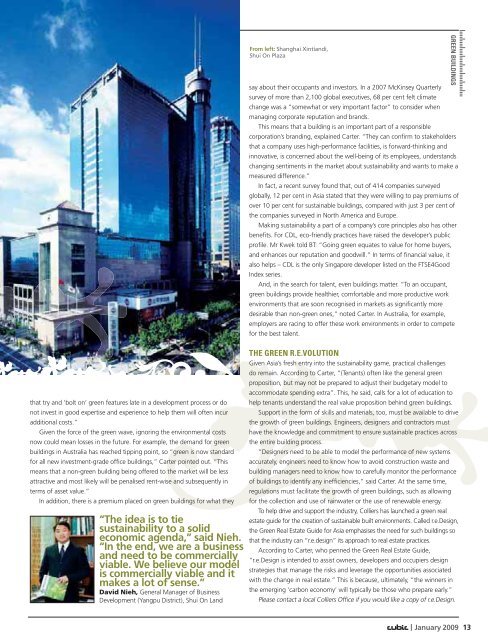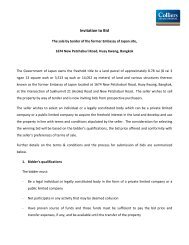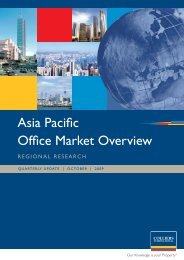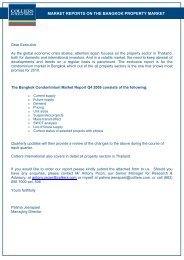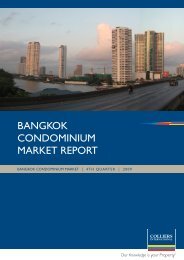CUBIC CoverDec08.indd - Colliers
CUBIC CoverDec08.indd - Colliers
CUBIC CoverDec08.indd - Colliers
You also want an ePaper? Increase the reach of your titles
YUMPU automatically turns print PDFs into web optimized ePapers that Google loves.
From left: Shanghai Xintiandi,<br />
Shui On Plaza<br />
say about their occupants and investors. In a 2007 McKinsey Quarterly<br />
survey of more than 2,100 global executives, 68 per cent felt climate<br />
change was a “somewhat or very important factor” to consider when<br />
managing corporate reputation and brands.<br />
This means that a building is an important part of a responsible<br />
corporation’s branding, explained Carter. “They can confirm to stakeholders<br />
that a company uses high-performance facilities, is forward-thinking and<br />
innovative, is concerned about the well-being of its employees, understands<br />
changing sentiments in the market about sustainability and wants to make a<br />
measured difference.”<br />
In fact, a recent survey found that, out of 414 companies surveyed<br />
globally, 12 per cent in Asia stated that they were willing to pay premiums of<br />
over 10 per cent for sustainable buildings, compared with just 3 per cent of<br />
the companies surveyed in North America and Europe.<br />
Making sustainability a part of a company’s core principles also has other<br />
benefits. For CDL, eco-friendly practices have raised the developer’s public<br />
profile. Mr Kwek told BT: “Going green equates to value for home buyers,<br />
and enhances our reputation and goodwill.” In terms of financial value, it<br />
also helps – CDL is the only Singapore developer listed on the FTSE4Good<br />
Index series.<br />
And, in the search for talent, even buildings matter. “To an occupant,<br />
green buildings provide healthier, comfortable and more productive work<br />
environments that are soon recognised in markets as significantly more<br />
desirable than non-green ones,” noted Carter. In Australia, for example,<br />
employers are racing to offer these work environments in order to compete<br />
for the best talent.<br />
GREEN BUILDINGS<br />
that try and ‘bolt on’ green features late in a development process or do<br />
not invest in good expertise and experience to help them will often incur<br />
additional costs.”<br />
Given the force of the green wave, ignoring the environmental costs<br />
now could mean losses in the future. For example, the demand for green<br />
buildings in Australia has reached tipping point, so “green is now standard<br />
for all new investment-grade office buildings,” Carter pointed out. “This<br />
means that a non-green building being offered to the market will be less<br />
attractive and most likely will be penalised rent-wise and subsequently in<br />
terms of asset value.”<br />
In addition, there is a premium placed on green buildings for what they<br />
“The idea is to tie<br />
sustainability to a solid<br />
economic agenda,” said Nieh.<br />
“In the end, we are a business<br />
and need to be commercially<br />
viable. We believe our model<br />
is commercially viable and it<br />
makes a lot of sense.”<br />
David Nieh, General Manager of Business<br />
Development (Yangpu District), Shui On Land<br />
THE GREEN R.E.VOLUTION<br />
Given Asia’s fresh entry into the sustainability game, practical challenges<br />
do remain. According to Carter, “(Tenants) often like the general green<br />
proposition, but may not be prepared to adjust their budgetary model to<br />
accommodate spending extra”. This, he said, calls for a lot of education to<br />
help tenants understand the real value proposition behind green buildings.<br />
Support in the form of skills and materials, too, must be available to drive<br />
the growth of green buildings. Engineers, designers and contractors must<br />
have the knowledge and commitment to ensure sustainable practices across<br />
the entire building process.<br />
“Designers need to be able to model the performance of new systems<br />
accurately, engineers need to know how to avoid construction waste and<br />
building managers need to know how to carefully monitor the performance<br />
of buildings to identify any inefficiencies,” said Carter. At the same time,<br />
regulations must facilitate the growth of green buildings, such as allowing<br />
for the collection and use of rainwater or the use of renewable energy.<br />
To help drive and support the industry, <strong>Colliers</strong> has launched a green real<br />
estate guide for the creation of sustainable built environments. Called r.e.Design,<br />
the Green Real Estate Guide for Asia emphasises the need for such buildings so<br />
that the industry can “r.e.design” its approach to real estate practices.<br />
According to Carter, who penned the Green Real Estate Guide,<br />
“r.e.Design is intended to assist owners, developers and occupiers design<br />
strategies that manage the risks and leverage the opportunities associated<br />
with the change in real estate.” This is because, ultimately, “the winners in<br />
the emerging ‘carbon economy’ will typically be those who prepare early.”<br />
Please contact a local <strong>Colliers</strong> Office if you would like a copy of r.e.Design.<br />
| January 2009 13


